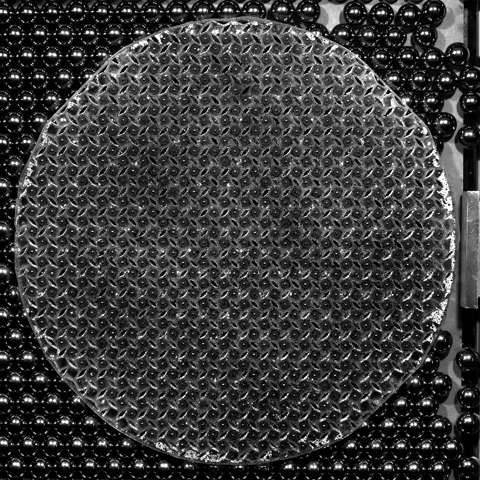
For Jordan Raney, assistant professor in the Department of Mechanical Engineering and Applied Mechanics, cutting-edge science sometimes involves whacking a rubber disc with a hammer.
In a recent experiment, he and Chengyang Mo, a graduate student in Raney’s Architected Materials Laboratory, used a 3D-printer to make this unusual, Frisbee-sized structure. It consists of hundreds of connected rubber squares, each with a ball bearing inside. It’s an example of a “mechanical metamaterial,” a class of systems that exhibit unusual physical behaviors stemming from their internal geometry rather than from the properties of the materials of which they’re made.
Raney and Mo were trying to understand the propagation of a unique type of nonlinear wave called a soliton. To do that, they placed their structure on top of ball bearings and set up a high-speed camera to record the wave’s motion at 6,000 frames per second. Then, according to their paper, published in the journal Physical Review Letters, they “excited the sample with an impactor” — or hit it with a $6 mallet from the hardware store.
Their study is the first to show how these waves travel in a soft 2D system.
“This is interesting because, in 2D, the wave changes dramatically depending on where you hit the squares,” says Mo. “When the impact is applied at a certain angle, the wave focuses itself and does not disperse as it moves.”
This behavior has been previously observed in granular materials, like sand, where it has been referred to as a “sound bullet.”
“It’s like a disturbance at the edge of a pond,” says Raney, “but instead of spreading outward in a circular fashion, the wave travels across the pond as one compact pulse. That way, all the energy of the input can be received by the output rather than spreading.”
A better understanding of mechanical metamaterials like the one Raney, Mo and their co-authors created could have biomedical applications, as impacting the body’s tissues with controlled pulses of energy could have diagnostic or therapeutic value. Aerospace, naval or automotive applications are also possible, with mechanical metamaterials rerouting the force of an impact away from people or payloads.
